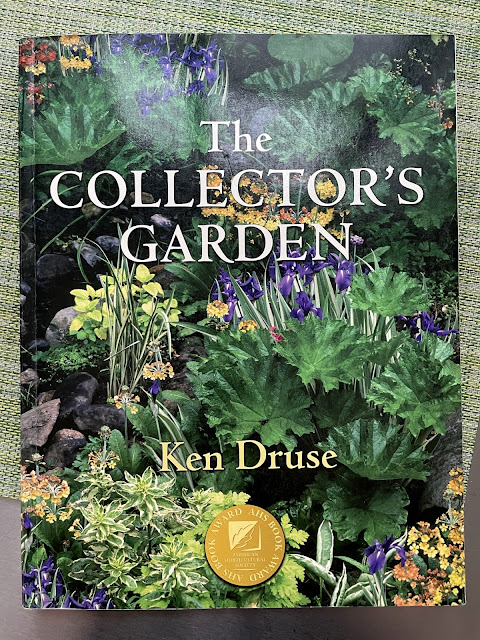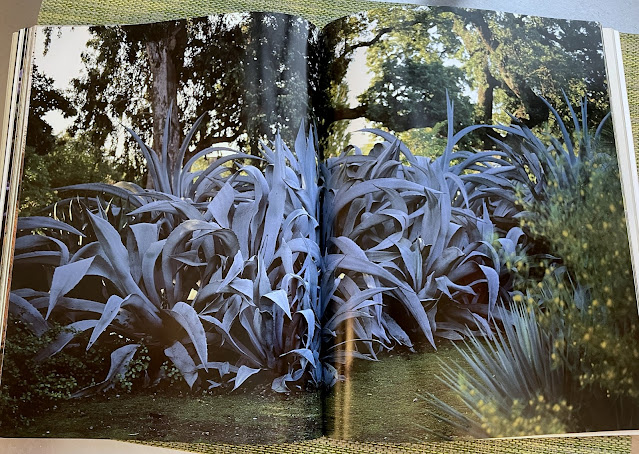Welcome to Chapter 2 of Book Bits—a quick look at the garden books I've been reading, along with a bit of brief commentary.
I long to be able to grow the gorgeous aeonium and echeveria my friends in California can grow, but since I can't I make do with sempervivum, hardy alpine hens and chicks. I feel like they should be my easy, go-to succulent, right?
Right. I thought I was doing pretty good until I visited the Denver area as part of the 2019 Garden Bloggers Fling. Oh my! Those people can grow sempervivum! Inspired by what I saw there I ordered Sempervivum: A Gardener’s Perspective of the Not-So-Humble Hens-and-Chicks by Kevin C. Vaughn (Schiffer Publishing, 2018). Perhaps this book would unlock the secrets?
Not so much. I should have known this book might not be fore me, since I can't even manage to keep the names straight on the sempervivum I do have (my issue, not the book's, obviously). There are however are a couple of bits from the book I thought I would pass on. The first one has to do with the sheer multitude of sempervivum there are, and this is just referring to the natural hybrids, not the fancy ones proliferating the marketplace.
Confusing.
And then there's this! It's so sad when I bring home a new 4" pot of some sempervivum and plant it out only to have it decide to bloom a few weeks later. Since they're monocarpic that's not ideal. Maybe knowing this will help...
— — —
Next up; American Roots: Lessons and Inspiration from the Designers Reimagining Our Home Gardens by Nick McCullough, Allison McCullough, and Teresa Woodard (Timber Press, 2022).
I checked this one out from the library and read it on my iPad. That right there should tell you a little about the book, as I do not read most garden books on my iPad, that's reserved for fiction, novels. This one however I really enjoyed reading in that format. The stories about each garden maker (designers), were so engaging that I found it hard to put down when it was time to go to sleep. I was surprised that I'd visited a couple of the gardens profiled in the book; that of Tait Moring and Scot Eckley, and enjoyed learning about the ones I had not. It's a good read, stories about gardeners—not at all what I was expecting, which was fancy talk about fancy gardens.
— — —
The next book is a modern oldie, The Collector's Garden by Ken Druse. It was originally released in 1996 in hardback form, by Clarkson Potter, then re-released in 2004 as a paperback from Timber Press. A Facebook friend mentioned learning about Marcia Donahue's garden via this book—Dan Hinkley was visiting Marcia recently and posted photos on Facebook—that sent me searching my shelves as I was sure I had the book somewhere...









Interesting info about sempervivum. Most varieties I grow spread nicely. Pulling out a spent bloom and its host has been, in my mind, an opportunity for thinning the clump. After reading the post though, I'll have to pay closer attention to semps that aren't as prolific and not allow them to bloom quite yet. It will be difficult to find the strength to decapitate them...
ReplyDeleteChavli
Some have really nice blooms, others are kind of scraggly. I'd hate to decapitate a nice one.
DeleteThanks for this post, Loree. I love Sempervivums and, although they're sold here, I generally avoid them as they don't live long in my climate. I do wish that there was as wide a variety of Aeoniums as there are Sempervivums but the degree of cross-breeding might make me crazy - Echeverias seem similar in that regard. The Druse book didn't sound familiar to me but I combed my garden bookshelf and found it! I'm guessing I bought it in 1996 when all I had was a dinky townhouse garden. I've pulled it out to give it a proper reading ;)
ReplyDeleteAh, excellent, I hope you enjoy it as much as I did.
DeleteI'll admit I've given up trying to keep my semps straight. Now I just buy by color. I lose a few to blooming every year, which is fine as they are interesting when they bloom. Maybe I should try and let them seed around instead of just taking the faded thing out . hmm, will think.
ReplyDeleteThere's a new twist, someone has discovered that Sempervivum and Aeonium are closely related and there are people beginning to experiment with crossing them. Think Hardy (ier) Aeonium!
https://www.rhs.org.uk/plants/plants-blogs/plants/june-2022/semponium-destiny
I've heard that Kevin Vaughn, the Sempervivum book guy, has done some of the breeding for the "Chick Charms" and new giant ones. They're getting more unique and interesting.
I haven't sat down and read "Roots" yet. Now I'm really looking forward to it. I may look for a used copy of the Druse book as well, I don't think I ever read that one.
Interesting, I've never thought of sempervivum as seeding about, just spreading by their "chicks". I've heard about that aeonium/sempervivum cross... will be interesting to see if/when it comes to market.
DeleteI think I own every Ken Druse book and have pretty much read them. Loved this one. I haven’t finished reading the Roots book but am pleased with the garden choices. I know the two from Wisconsin.
ReplyDeleteI thought they did a great job of selecting gardens for that book.
DeleteGood post!
ReplyDeleteThank you.
DeleteThanks for the book recommendations. Interesting technique with the semp rosettes. I occasionally grow them in my potted succulent gardens, and now I'll have a potential way to prevent demise. Thanks.
ReplyDeleteLet me know if it works!
DeleteI have The Collectors Garden which was gifted to me many years ago -mine is paperback so I guess it would be post 2004. I loved that book, but like you I haven't opened it in years. I pulled it out when I read your post and realized that like you there were gardens Ken wrote about that I was unfamiliar with back then and have visited since. And thanks for the review on American Roots. By the way, I have given up on Semps. They don't like it here.
ReplyDeleteMy copy was a gift as well, it has a friend's signature on the inside cover, so I know she enjoyed it before passing it on. Isn't it interesting how small the gardening world has gotten? Seems we're all connected—which is a very nice thing.
DeleteReading a book on sempervivums would be rather like visiting gardens in England or listening to Gardeners Question time on a podcast. Just for the sheer pleasure of seeing the variety and how beautiful they look and hearing about what others can grow. I have never lived anywhere where these plants would work in my garden. Well, maybe a long time ago. I remember seeing them growing on the roof at Great Dixter. I enjoyed your posting on these books.
ReplyDeleteMy brother moved from Spokane to Phoenix and took some sempervivum with him. That didn't work out so well for the plants...
Delete